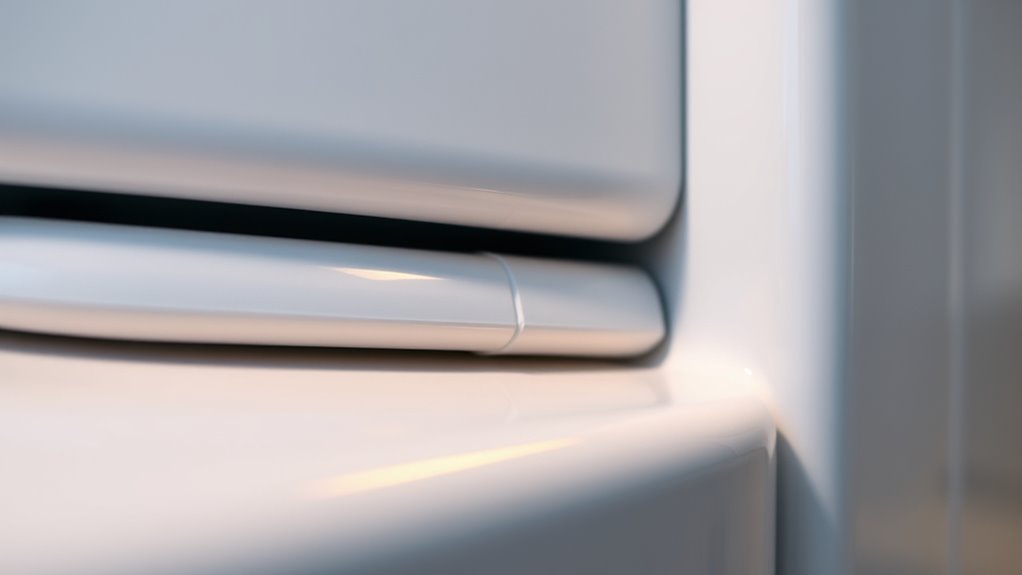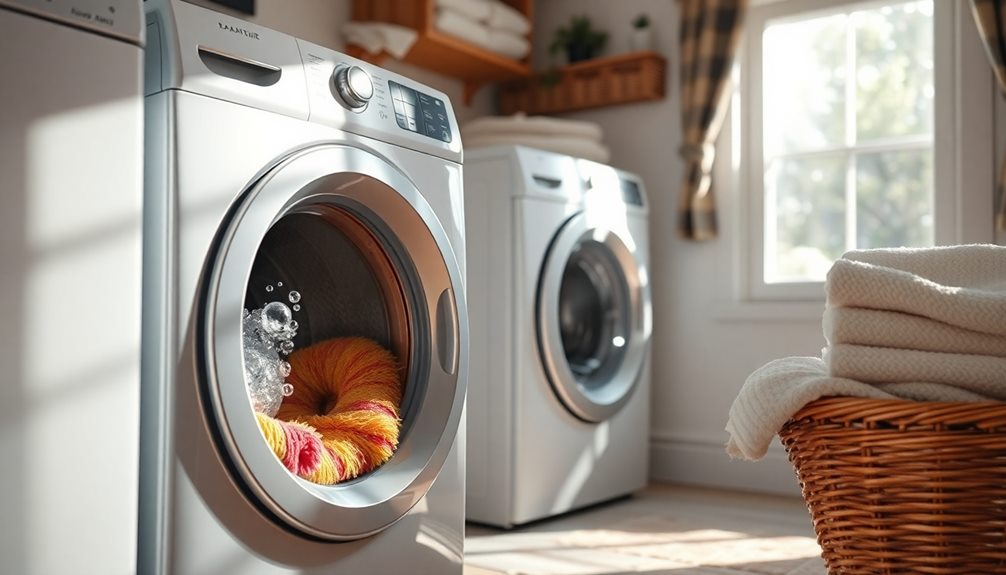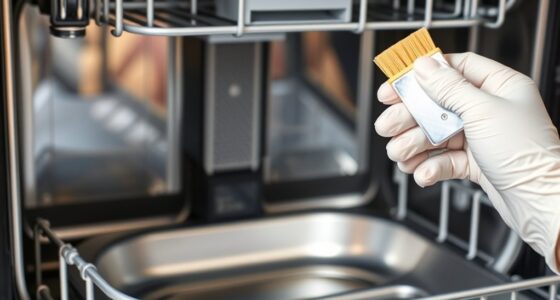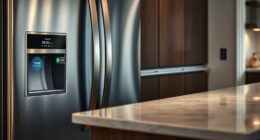To identify if your refrigerator door seal leaks, start with a visual check for cracks, tears, or debris, and clean the seal thoroughly. Use the dollar bill test by closing the door on a bill and seeing if it slips out easily; repeat along the edges. You can also shine a flashlight around the seal in a dark room or hold an incense stick near the gasket to spot light or smoke seepage. Feel for drafts or cold spots, and listen for hissing sounds indicating leaks. If you continue, you’ll discover more effective ways to ensure your seal stays intact.
Key Takeaways
- Perform the dollar bill test along the door edges to check for gaps and leaks.
- Shine a flashlight around the seal in a dark room to spot light seepage indicating gaps.
- Use a smoked or incense stick near the seal; fluttering smoke reveals leaks.
- Feel for drafts or cold spots along the seal to detect escaping air.
- Listen for hissing or whistling sounds during door closure, indicating potential seal leaks.
Visual Inspection of the Door Seal

Have you ever wondered how to quickly identify if your refrigerator door seal is leaking? The first step is a simple visual inspection. Open the door and examine the seal closely. Look for cracks, tears, or areas where the rubber appears worn or deformed. Check for any gaps between the seal and the door frame; these indicate that the seal isn’t making a tight fit. Also, inspect for mold, debris, or sticky residues that might prevent a proper seal. Run your fingers along the entire perimeter, feeling for unevenness or damage. If the seal looks intact but you still suspect a leak, clean it thoroughly to remove dirt or food particles that could hide issues. A careful visual check can reveal many common problems early, especially if you pay attention to seal integrity and how well the door fits. Additionally, inspecting the door alignment can help identify underlying causes of seal failure. Regularly checking the door gasket condition can also prolong the lifespan of your appliance and improve efficiency. Being aware of common seal issues can help you address problems before they worsen. Monitoring for costly repairs related to leaks can save you money in the long run.
The Dollar Bill Test
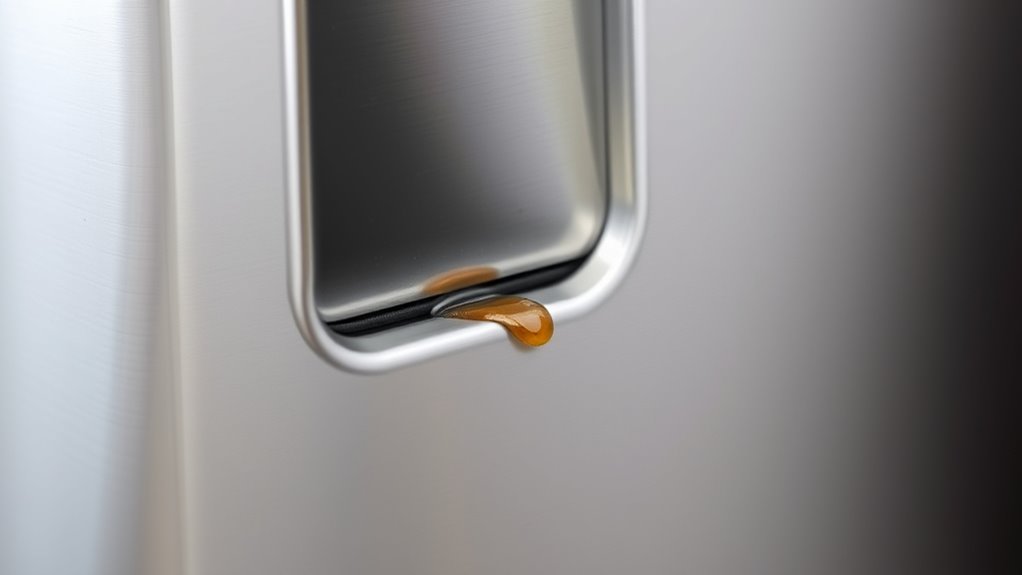
You can quickly check your door seal by using a dollar bill. Close the door on the bill and see if it slips out easily or feels tight. The way the bill behaves helps you interpret whether the seal is still effective or needs replacement.
Using a Dollar Bill
Wondering if your refrigerator door seal is tight enough? The Dollar Bill Test is a simple way to check. Open the door slightly and place a dollar bill between the door and the fridge frame. Close the door gently, and then pull the bill out. If it slides out easily without resistance or feels loose, your seal may have leaks or gaps. If the bill stays firmly in place or requires effort to remove, your seal is likely tight. Repeat this process along different sections of the door to identify any weak spots. This quick test helps you spot potential issues before they become major problems, saving energy and preventing food spoilage. Remember, a good seal keeps your fridge running efficiently, especially when considering water efficiency in appliances. Ensuring your door seal is intact can also contribute to an overall energy-efficient lifestyle.
Interpreting Test Results
Interpreting the results of the Dollar Bill Test is straightforward. If the bill slips out easily, your door seal likely has a leak. If it’s snug or requires force to remove, your seal is probably intact. Use this table to understand what your test indicates:
| Bill stays put | Seal is likely good | No leak detected |
|---|---|---|
| Bill falls out easily | Seal may be leaking | Needs further check |
| Slight resistance | Possible minor leak | Monitor over time |
| Very tight fit | Seal is effective | No issues |
Additionally, practicing mindfulness during the inspection process can help you stay focused and calm as you evaluate your refrigerator seal. Being aware of common signs of leaks can also improve your detection accuracy. Recognizing proper sealing techniques can further assist in maintaining an effective seal and preventing energy loss. Understanding the importance of a proper seal is essential to ensure your refrigerator operates efficiently and conserves energy. Moreover, understanding how to test seals properly can help you perform more accurate assessments and maintain optimal appliance performance.
Using a Light Source to Detect Gaps

Using a light source is an effective way to identify gaps in your refrigerator door seal. Turn off the interior light and close the door in a dark room. Shine a flashlight or small torch along the edges of the door seal. If you see light seeping through, it indicates gaps where cold air could escape. Pay close attention to corners and seams, as these are common weak spots. Move the light slowly around the perimeter to ensure you don’t miss any leaks. This method provides a clear visual cue, making it easy to pinpoint exactly where the seal isn’t tight enough. Regularly checking your door seal can also help prevent energy loss and reduce your electricity bills. Additionally, inspecting for wear and tear can help you determine if the seal needs cleaning or replacement to maintain optimal fridge performance. Staying aware of signs of a faulty seal can help you address issues early and improve overall efficiency. Incorporating tuning Hyundai models can improve the overall efficiency of your vehicle, just as maintaining your fridge seal optimizes its operation. Furthermore, understanding the importance of WWE Raw’s Financial Impact highlights how critical proper maintenance and strategic investments are in sustaining success.
Checking for Cold Air Escaping
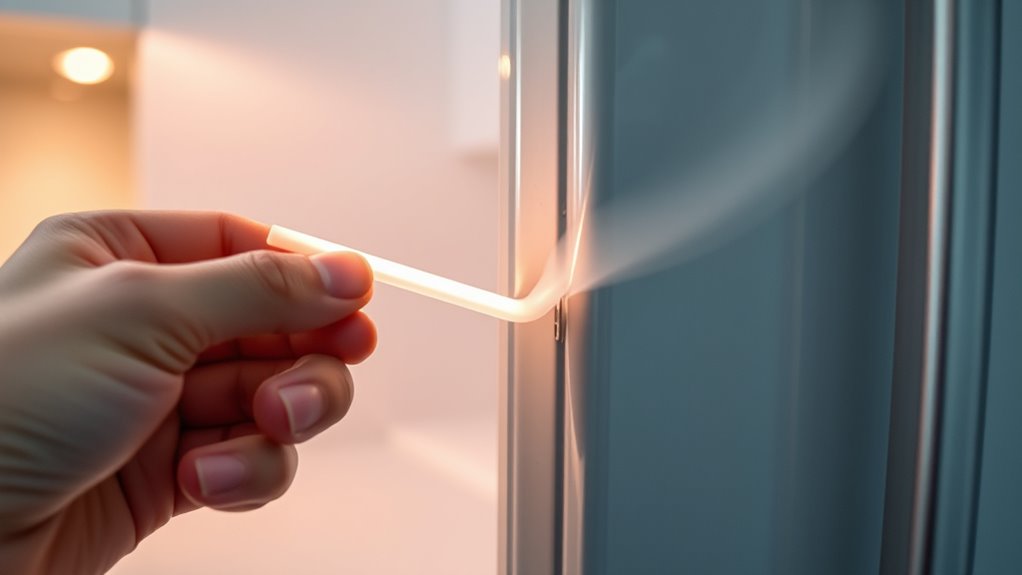
After identifying potential gaps with a light source, the next step is to check if cold air is actually escaping from your refrigerator. Close the door firmly, then stand close and feel along the edges for drafts. You can also use a dollar bill or a piece of paper; place it between the door and the fridge, then gently tug. If the paper slips out easily, cold air is escaping. Repeat this process around the entire door seal to identify all leaks. For a more thorough test, run your hand along the seal to feel for cold spots or air movement. Performing a seal integrity test can help ensure the entire perimeter is properly sealed. Addressing these leaks promptly helps maintain the fridge’s efficiency and keeps your food fresh longer. This simple check confirms whether your seal needs repair or replacement.
Listening for Hissing or Whistling Sounds
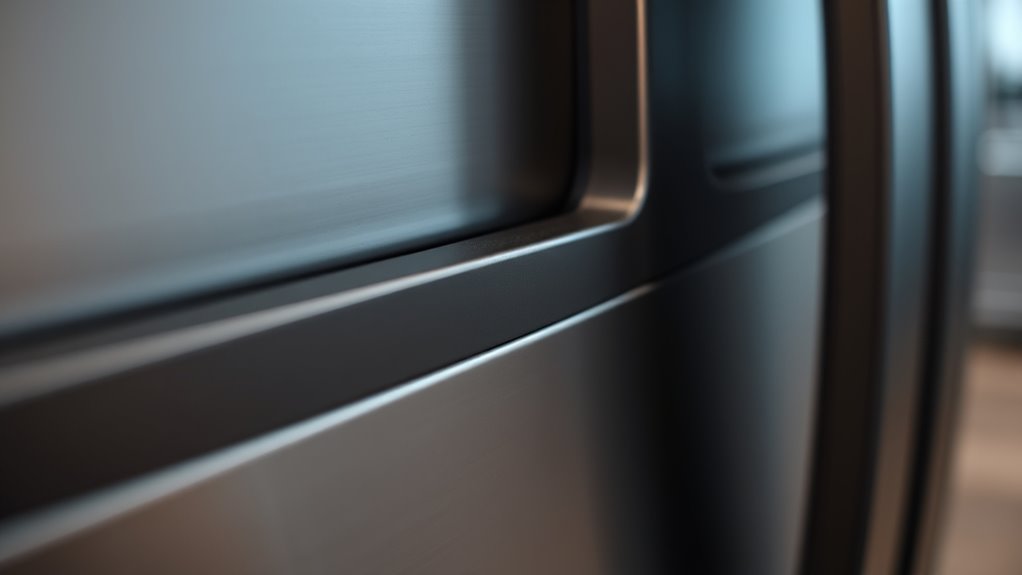
As you listen near the door seal, pay attention to any hissing or whistling sounds that seem out of place. These noises can indicate leaks or pressure issues, so recognizing them is key. Using simple sound localization techniques and inspecting the equipment can help you identify the exact source of the problem.
Recognizing Unusual Noises
Unusual noises like hissing or whistling coming from your refrigerator door seal can signal a leak or improper contact. These sounds often occur when air escapes through tiny gaps, creating a high-pitched noise. If you notice a persistent hissing or whistling, it indicates that the seal isn’t sealing properly. Pay attention to when the noise happens—usually when the door is closed or opened. Sometimes, the sound may fluctuate with temperature changes or door movements. Recognizing these noises early helps you identify potential leaks before they cause energy loss or spoilage. Trust your ears; any unusual sound that wasn’t there before warrants further inspection. Addressing these noises promptly can help ensure your refrigerator maintains its efficiency and the door seal stays intact.
Equipment Inspection Tips
Listening carefully during equipment inspection is essential for detecting hissing or whistling sounds that indicate a seal leak. These sounds often signal air escaping or a vacuum forming, which can compromise your refrigerator’s efficiency. To improve your chances of identifying these noises:
- Use a stethoscope or place your ear close to the door seal area.
- Listen for high-pitched sounds when the compressor runs.
- Note any unusual hissing or whistling that persists.
- Pay attention to sounds that change when the door is opened or closed.
Sound Localization Techniques
To accurately identify a leak in your refrigerator door seal, mastering sound localization techniques can make all the difference. Start by closing the door tightly and then listen carefully around the edges. Move your ear slowly along the perimeter, focusing on areas where you hear hissing or whistling sounds. Use your hand to help direct sound waves toward your ear if needed. Pay attention to subtle noises that may be faint or intermittent. If you hear a consistent high-pitched whistle or a hissing sound, it indicates escaping air. Don’t rush—patience helps in pinpointing the exact location of the leak. By honing your listening skills and focusing on sound cues, you can effectively locate the seal leak with confidence.
Monitoring Temperature Fluctuations Inside the Fridge
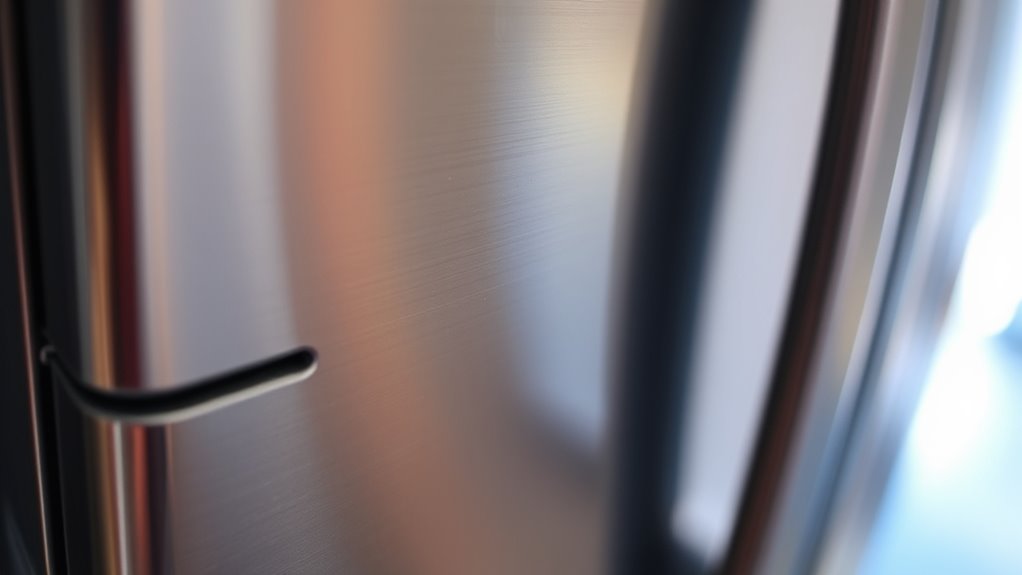
Monitoring temperature fluctuations inside your fridge is essential to guarantee your food stays fresh and safe. Sudden changes can indicate a seal leak or malfunction. To keep track, use a digital thermometer placed inside to observe temperature consistency over several days. Look for unexpected spikes or drops that don’t align with normal usage. Consider setting up a temperature log to identify patterns. Regularly check for these signs:
- Temperature rises above 40°F (4°C) for extended periods
- Cold spots or uneven cooling
- Frequent door openings causing temperature swings
- Refrigerator running constantly or cycling excessively
Using a Smoked or Incense Stick to Spot Leaks

Have you ever wondered how to quickly find leaks in your refrigerator door seal? Using a smoked or incense stick is an easy and effective method. Light the stick and hold it near the door gasket while slowly opening and closing the door. Watch the smoke or incense as it interacts with the seal; if there’s a leak, the smoke will flutter or be drawn toward the gap. Pay close attention to areas where the smoke’s movement is disturbed. Make certain you perform this test in a draft-free environment for accurate results. This simple technique helps you visually identify leaks without needing special tools, saving you time and effort. Once you spot the leak, you can take steps to repair or replace the seal to improve your refrigerator’s efficiency.
Conducting a Feel Test for Air Flow

Conducting a feel test for air flow is a straightforward way to detect leaks in your refrigerator door seal. To do this, close the door and gently run your hand along the edges of the seal. Pay attention to any drafts or cool air escaping. You might notice a slight sensation of air moving, especially around the corners or seams. This method helps you identify specific areas where the seal may be compromised.
Here are some tips to improve your test:
- Use your hand to feel for cold drafts or air currents
- Check while the room is cooler for better results
- Test at different times of day for consistency
- Combine with visual inspections for best accuracy
Frequently Asked Questions
How Often Should I Check My Refrigerator Door Seal for Leaks?
You should check your refrigerator door seal regularly, ideally once a month, to guarantee it’s airtight. Look for gaps, tears, or dirt that can compromise the seal’s effectiveness. If you notice any leaks or the door isn’t closing properly, inspect it more often. Keeping the seal clean and intact helps your fridge run efficiently, saves energy, and prevents food spoilage. Regular checks make sure your appliance stays in top shape.
Can a Damaged Seal Affect My Fridge’S Energy Efficiency?
A damaged seal can substantially impact your fridge’s energy efficiency. When the seal is compromised, cold air escapes and warm air enters, forcing your refrigerator to work harder to maintain the right temperature. This increased effort uses more energy, raising your utility bills. Regularly checking and replacing a worn or damaged seal helps keep your fridge running efficiently, saves money, and prevents spoilage caused by temperature fluctuations.
Are There Specific Seal Materials That Last Longer?
You want to know which seal materials last longer. Generally, rubber and silicone seals are durable and resistant to wear, making them ideal choices. Silicone seals, in particular, withstand extreme temperatures and won’t crack or degrade quickly, so they tend to last longer than other materials. Regular maintenance, like cleaning and proper alignment, also helps extend their lifespan. Choosing high-quality, weather-resistant seals ensures your fridge stays energy-efficient and leak-free longer.
What Signs Indicate a Seal Needs Replacement Besides Leaks?
When you notice your refrigerator isn’t maintaining proper temperature, it might be time to check the door seal. Warped or cracked seals, condensation buildup, or increased energy bills are also signs you need a replacement. If your door doesn’t close tightly or feels loose, these are clear indicators. Regularly inspecting your seal for signs of wear helps guarantee your fridge stays efficient and your food stays fresh.
How Do Temperature Fluctuations Impact Food Safety?
Temperature fluctuations can seriously impact your food safety. When your fridge’s temperature isn’t stable, harmful bacteria can grow, making food unsafe to eat. You might notice spoilage or strange odors, which are signs of inconsistent cooling. To keep your food safe, guarantee your fridge maintains a steady temperature, ideally around 37-40°F. Regularly check your thermostat and avoid overloading your fridge, so cold air circulates properly.
Conclusion
Remember, a leak in your fridge door seal can lead to wasted energy and spoiled food. By regularly inspecting and testing the seal, you catch problems early and save money. Don’t wait until it’s too late—sometimes, a small leak can turn into a big problem. As the saying goes, “An ounce of prevention is worth a pound of cure.” Stay vigilant, and keep your fridge running efficiently!
